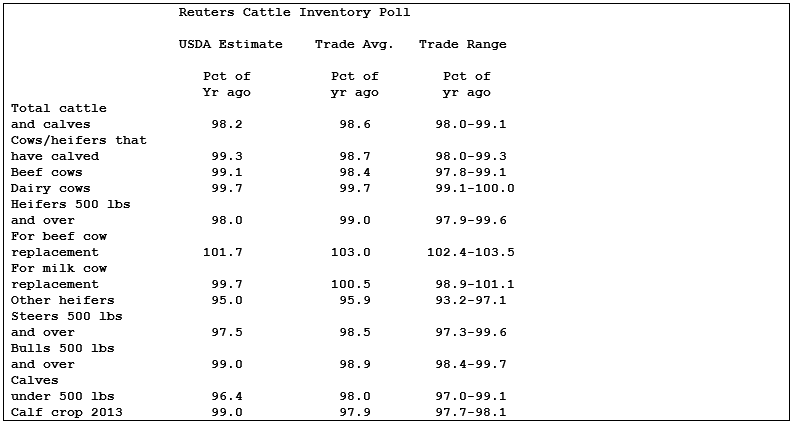Market News & Headlines >> Brock Report - Cattle Herd Smallest Since 1951
Friday afternoon’s annual USDA Cattle Inventory Report showed the smallest U.S. cattle herd since 1951, but also suggested that the current round of herd liquidation may have come to an end.
USDA pegged all U.S. cattle and calves at 87.73 million head, 98.2% of a year earlier compared with trade estimates averaging 98.6% in a range from 98.0%-99.1%.
The total cow herd was pegged at 38.25 million head or 99.3% of a year earlier, matching the high end of pre-report estimates that averaged 98.7%, while the beef cow herd came in at 99.1% of a year earlier, also at the high end of expectations.
The state-by-state breakdown showed the beef cow herd up 6% from last year in Kansas and up 3% in Oklahoma, but down another 3% in Texas.
USDA put the number of heifers retained for beef cow replacement purposes at 101.7% of a year earlier, below the range of trade estimates. The number of heifers expected to calve during 2014 was pegged at 101.2% of a year earlier.
Cattlemen in Kansas retained 10,000 more heifers or 4.3% more heifers for beef cow replacement during 2013 than in 2012, while Oklahoma producers retained 45,000 or a hefty 16% more. Texas producers, however, kept 40,000 head or 6.7% fewer heifers for beef replacement.
The 2013 calf crop was pegged at 33.93 million head, the smallest on record going back to at least 1962, but at 99% of a year earlier, above the range of trade expectations. Notably, the Kansas calf crop was up 2.4%, while the Texas calf crop was down 1.3%.
The inventory report indicated the supply of cattle in U.S. feedlots is not down quite as much from last year as was previously thought, which may limit the upside for cattle prices. The total supply of cattle in all U.S. feedlots as of Jan. 1 came in at 95% of a year earlier, above the 94.6% indicated by the recently-released USDA Cattle-on-Feed Report, which surveys only feedlots of 1000 head or more.
